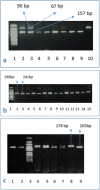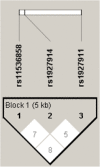TLR4 gene polymorphisms in Egyptian vitiligo patients: insights into emerging association with clinical activity, family history, and response to therapy
- PMID: 34468896
- PMCID: PMC8410933
- DOI: 10.1186/s43141-021-00218-y
TLR4 gene polymorphisms in Egyptian vitiligo patients: insights into emerging association with clinical activity, family history, and response to therapy
Abstract
Background: Vitiligo is a common pigmentary disorder in which autoimmunity has been suggested to play an important role. Toll-like receptor (TLR) family are recognized different molecular structures expressed on immune cells and have been implicated in a number of autoimmune diseases (AIDs) such as vitiligo. The purpose of this study was to investigate the possible association between TLR4 gene polymorphisms: rs11536858, rs1927911, rs1927914 in Egyptian vitiligo patients and their clinical data, their response to therapy. Using PCR-RFLP for TLR4 gene polymorphisms (rs11536858, rs1927911, and rs1927914), both alleles and genotypes were determined after extraction of DNA in a case-control study of 100 vitiligo Egyptian patients and 100 matched age and sex controls.
Results: The distribution of the protective CT genotype of rs1927914 was higher in the control group. After dividing both patients and controls into 2 age groups (below 18 and above 18 years), no significant associations between the genotypes of the selected TLR4 SNPs and the demographic and clinical data of the vitiligo patients in group 1 (below 18 years) were observed. For group 2 (above 18 years), also no significant associations were found except for the association between the CC genotype of rs1927914 and psychiatric trauma, from one side, and between the CT genotype of rs1927911 and alopecia, from the other side. The association between combined genotypes and the risk of vitiligo showed either higher frequency in patients (risky), or controls (protective), and some equal frequencies (non-significant). The association between haplotypes and risk of vitiligo in patients' group revealed the highest frequency for the risky ATT and the least frequency for ATC haplotypes. In control group, the protective GCT haplotype showed the highest frequency while the GTC and GCC showed the least frequency. No significant correlations of haplotypes with clinical and demographic data of selected patients' group were observed apart from that between ACC haplotype and family history of AIDs and between ATT haplotype and remission after phototherapy.
Conclusions: The significant relationship between TLR4 gene polymorphisms and vitiligo patients charcteristics clarify the role of innate immunity in pathogensis of vitiligo and its effect on the used therapies.
Keywords: Autoimmunity; Egyptian; Innate immunity; TLR4; Vitiligo.
© 2021. The Author(s).
Conflict of interest statement
The authors declare that they have no competing interests.
Figures


References
-
- Arican O, Kurutas EB. Oxidative stress in the blood of patients with active localized vitiligo. Acta dermatovenerologica Alpina, Panonica et Adriatica. 2008;17:12–16. - PubMed
LinkOut - more resources
Full Text Sources
Research Materials
